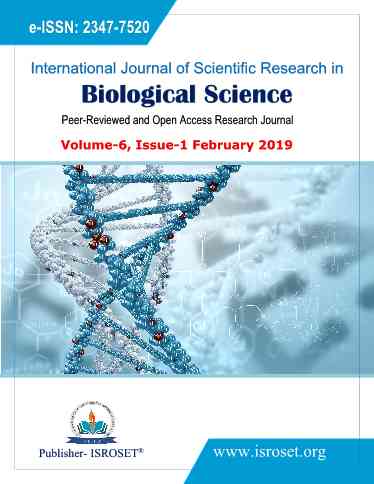Taxonomic and Phylogenetic study of Termitomyces entolomoides in western Assam
Keywords:
Termitomyces, identification, ITS region, molecular phylogenyAbstract
Termitomyces genus is paleotropical in nature and is known for its obligate symbiotic association with termites belonging to Macrotermitinae. The Termitomyces sample was collected during the monsoon and post monsoon period (April-October). The basidiocarp was oven dried and used for the macro-morphological and micro-morphological studies. Identification of fungi using morphological characters is very complicated and error prone. Furthermore, internal transcribed spacer (ITS) region 1, 5.8S rRNA gene and ITS 2 region was amplified using ITS 1 and ITS 4 primer pairs. The amplicon of ~600 bps was sequenced and subjected to Phylogenetic analysis in MEGA X sowftware package. Newly obtained sequence and 19 sequences of Termitomyces from NCBI GenBank were aligned using MAFFT. Phylogenetic tree was constructed using Maximum Likelihood method with bootstrap values of ≤ 70 %. The morphological characters and molecular data indicate the studied sample as Termitomyces entolomoides. Phylogenetic relationship of the studied species with 19 Asian Termitomyces species obtained from NCBI GenBank is established and is clearly monophyletic.
References
J. O. Kuja, H. I. Boga, V .Matiru, H. M Makonde, “Diversity, properties and ecological significance of the genus Termitomyces associated with fungus farming termites in Africa”, International Journal of Micro Mycol , Vol 2, pp. 29-36, 2014.
S. Siddiquee, K. Rovina, L. Naher, K. F. Rodrigues, M.A. Uzzaman, "Phylogenetic relationships of Termitomyces aurantiacus inferred from internal transcribed spacers DNA sequences", Advances in Bioscience and Biotechnology 6, no., 5, pp. 358-367, 2010.
D.N. Pegler, M. Vanhaecke, “Termitomyces of Southeast Asia”, Kew Bulletin,Vol 49, pp. 717-736,1994.
N.C. Karun, K.R. Sridhar, “Occurrence and distribution of Termitomyces (Basidiomycota, Agaricales) in the Western Ghats and on the west coast of India”, Czech Mycology, Vol 2, no., 65, pp. 233-254, 2003.
D. C. Mossebo, E. P. F. Essouman, M. C. Machouart, C. Gueidan. "Phylogenetic relationships, taxonomic revision and new taxa of Termitomyces (Lyophyllaceae, Basidiomycota) inferred from combined nLSU-and mtSSU-rDNA sequences." Phytotaxa, Vol 321, no., 1, pp. 71-102, 2017.
T.G. Frøslev, D.K. Aanen, T. Laessoe, S. Rosendahl, “Phylogenetic relationships of Termitomyces and related taxa”, Mycological research, Vol 107, pp. 1277-1286, 2003.
R. Heim, “Termites et Champignons. Les champignons termitophiles d’Afrique Noire et d’Asie me’ridionale”, E’ditions Boube’e, Paris, pp. 205, 1977.
C.R. Woose , G.J, Olsen, “Archaebacterial phylogeny: perspectives on the urkingdoms”, Syst Appl Microbiology, no., 7, pp. 167-177, 1986.
T. J. White, T. Bruns, S. J. W. T. Lee, J. L. Taylor, “Amplification and direct sequencing of fungal ribosomal RNA genes for phylogenetics”, PCR protocols: a guide to methods and applications, Vol 1, no., 18, pp. 315-322, 1990.
G. Gogoi, V. Parkash, “ A checklist of gilled mushrooms (Basidiomycota: Agaricomycetes) with diversity analysis in Hollongapar Gibbon Wildlife Sanctuary, Assam, India”, Journal of Threatened Taxa,Vol 15, no., 7, pp. 8272-8287, 2015.
M. Basumatary, M. Gogoi, “Uses of wild edible macro fungi by Bodo community of Kokrajhar district, Assam, India”, An International Journal of Tropical Plant Research, Vol 3, pp.176-181, 2016.
M. Rava, R. Ali, H. Boro, S. Das, “ Additional record of Termitomyces heimii, Kokrajhar, Assam, INDIA”, Mushroom Research,Vol 26, pp.133-137, 2017.
T.C. Sarma, I. Sarma, B.N. Patiri, “Wild edible mushrooms used by some ethnic tribes of Western Assam”, The Bioscan, Vol 3, pp. 613-625, 2010.
K.D. Singha, K.D.K. Singha, “Occurrence of Termitomyces microcarpus mushroom in Assam”, Advances in Plant Sciences, Vol 23, pp.439-440, 2010.
A. Kornerup, J. H. Wanscher, “Methuen handbook of colour”, 1963.
J. Doyle, J. L. Doyle, “Genomic plant DNA preparation from fresh tissue-CTAB method”, Phytochem Bull, Vol 11, no., 19, pp. 11-15, 1987.
D. Darriba, G.L. Taboada, R . Doallo, D. Posada, "jModelTest 2: more models, new heuristics and parallel computing”, Nature Methods, Vol 8, no., 9, pp.772, 2012.
K. Tamura, G. Stecher, D. Peterson, “MEGA6: Molecular Evolutionary Genetics Analysis Version 6.0”, The Society for Molecular Biology and Evolution, Oxford University, Oxford, 2013.
K.M. Leelavathy, L . Flower, C.P. Suja, “The genus Termitomyces in India”, In: Kaul TN, Kapoor B.M., eds., Indian Mushroom Science II, New Delhi, pp. 402–407, 1983.
C.K. Pradeep, K.B. Vrinda, “Some noteworthy agarics from Western Ghats of Kerala”, Journal of Mycopathological Research, Vol 45, pp. 1–14, 2007.
L.C. Rouland, , M. D. Ngor, A. Brauman, M. Neyra, “Phylogenetic Relationships in Termitomyces (family Agaricaceae) based on the nucleotide Sequence of ITS: A first approach to elucidate the Evolutionary History of the Symbiosis between Fungus-Growing Termites and their fungi”, Molecular Phylogenetics and Evolution , Vol 3, no., 22, pp. 423–429, 2002.
P. Sawhasan, J. Worapong, T. Vinijsanun, “Morphological and Molecular studies of selected Termitomyces species collected from 8 districts of Kanchanaburi Province, Thailand”, Thai Journal of Agricultural Science, Vol 3, no., 44, pp.183–196, 2011.
Y. Taprab, M. Ohkuma, T. Johjima, Y. Maeda, S. Moriya, T. Inoue, P. Suwanarit, N. Noparatnaraporn, T. Kudo, “Molecular Phylogeny of Symbiotic Basidiomycetes of Fungus-growing Termites in Thailand and Their Relationship with the Host”, Bioscience, Biotechnology and Biochemistry, Vol 5, no., 65, pp.1159–1163, 2002.
Downloads
Published
How to Cite
Issue
Section
License

This work is licensed under a Creative Commons Attribution 4.0 International License.
Authors contributing to this journal agree to publish their articles under the Creative Commons Attribution 4.0 International License, allowing third parties to share their work (copy, distribute, transmit) and to adapt it, under the condition that the authors are given credit and that in the event of reuse or distribution, the terms of this license are made clear.







